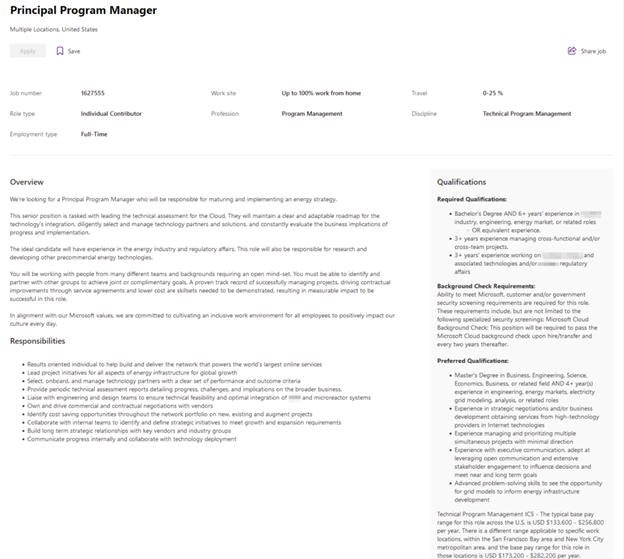I’ve got something of a puzzle for you today…
It involves a job listing — from none other than tech juggernaut Microsoft Corp. (Nasdaq: MSFT).
No, I’m not planning on going anywhere.
But when it comes to investing research, no public data is really “out of bounds” for my team…
We’ll scour everything from press releases and quarterly updates to third-party analysis and, yes, even job listings.
In this case, I’ve found a listing that speaks volumes about MSFT’s future in tech.
First, have a look for yourself and see if anything seems out of place.
Take a few minutes and really look it over if you like:

Notice anything out of place?
Specifically — why is Microsoft willing to shell out $282,000 per year for an energy executive?

After all, isn’t this a company that specializes in hardware and software … not power generation and transmission?
Why does a high-tech company like Microsoft need someone who’s got “experience in the energy industry and regulatory affairs?”
The answer to these questions isn’t so farfetched.
Especially for those who understand what’s going on right now in the world of Big Data and AI…
As I explained in Friday’s Banyan Edge, today’s modern internet consumes a massive amount of electrical power.
In 2022, the internet soaked up more than 800 terawatts of electricity, according to a study from Thunder Said Energy.
And we’re not slowing down. Another study projects the IT industry will use up 20% of the world’s power by 2025.
That means the internet will soon use the same amount of energy used by India, the world’s most populous country with 1.4 billion residents.
A substantial portion of that power is consumed by massive “data centers” used to back up the cloud.
And sure enough — MSFT controls 20% of America’s data centers.
These data centers are a crucial part of the company’s business model, too — contributing more than $31 billion in quarterly revenue to MSFT.
That’s why Microsoft is paying top dollar to get new energy projects off the ground.
If it can reduce energy consumption or cost by even just a few percent, it could be worth billions of dollars to the tech giant.
Google is already diving into similar projects…
And other tech leaders, such as Meta and Palantir, are bound to follow.
Of course, this isn’t just about saving a few dollars on the data centers of today.
It’s also about controlling one of the most critical resources for the next phase of the AI revolution…
AI Power Is Up for Grabs
After launching ChatGPT in November 2022, Sam Altman and OpenAI rocketed to the forefront of the AI revolution.
Altman’s forward-looking genius (as Matt touched on yesterday) makes him a natural spokesperson for the fast-growing AI industry. But in a recent interview, Altman cautioned investors:
I think we still don’t appreciate the energy needs of this technology.
He’s not alone, either.
The International Energy Agency (IEA) projects AI research will have a massive impact on existing data centers and power grids.
It added that by 2026, just a few years into its infancy, AI research and development will consume as much electricity as the entire nation of Japan.
That’s why I’m hosting my “AI Power Summit” this Thursday, May 9 at 1 p.m. ET.
During this special video event, I’ll share an unedited deep dive into some of the cutting-edge technologies and investments that could soon fuel the next phase of the AI revolution.
Sign up HERE to lock in your free invitation.
I can’t wait to show you how we’re going to gain an edge in the ongoing AI revolution.
To good profits,

Adam O’Dell
Chief Investment Strategist, Money & Markets



